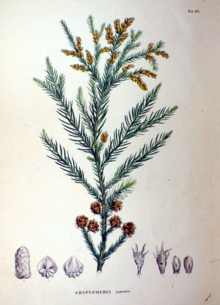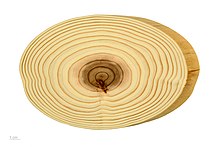Crescent fir
| Crescent fir | ||||||||||||
|---|---|---|---|---|---|---|---|---|---|---|---|---|

Sickle fir ( Cryptomeria japonica ) |
||||||||||||
| Systematics | ||||||||||||
|
||||||||||||
| Scientific name of the genus | ||||||||||||
| Cryptomeria | ||||||||||||
| D. Don | ||||||||||||
| Scientific name of the species | ||||||||||||
| Cryptomeria japonica | ||||||||||||
| ( Thunb. Ex L. f. ) D.Don |
The Japanese cedar ( Cryptomeria japonica ) or Sugi ( Japanese 杉 ), and Japanese cedar known, is the only plant of monotypic genus Cryptomeria in the family of cypress plants (Cupressaceae).
description
Appearance
The crescent fir is an evergreen tree that can grow to heights of 50 meters in its homeland, but only around 15 meters in Central Europe. The trunk is straight and slender. The relatively soft bark is initially noticeably red-brown and turns dark brown with age; it separates from the trunk in longitudinal strips. The canopy is dense beastet, conical or pyramidal and ends around the summit. The long young twigs are often drooping, with the Chinese variety having slacker twigs than the Japanese.
Needles
The fresh green hard needles are up to 30 millimeters long and are long and pointed, their base runs down the branch. The Chinese variety has longer needles than the Japanese. The needles are spiraling on the branch, are curved crescent-shaped (hence crescent fir) and have rows of stomata on both sides.
Flowers, cones and seeds
The crescent fir is single-sexed ( monoecious ).
The male cones stand in the axils of needle leaves in groups of about 20 at the end of side branches. When immature they are green, when ripe they are yellow to orange. In Japan , pollen , which occurs from February to April, is the most common cause of hay fever , also because the trees make up about 12% of the country's area.
The female cones stand at the end of short branches and are sloping downwards during flowering. They are similar to a shower head. Per cone scale (two to) three ovules are formed, which are located in the axilla of the cover scale. After pollination , the cones grow and turn upwards by about 180 ° so that the ripe, brown cones stand upright on curved stems. They are up to 3 inches long. At maturity, large parts of the seed and cover scales have grown together in the lower area, and only the tips are free. The seed scale is usually characterized by five thorn-shaped teeth, the tip of the cover scale is curved backwards. In the sickle fir, it is not uncommon for the cones to grow through, with a short leafy branch at the top of the cone. The seeds ripen in the year of pollination, they are about 6 millimeters long and narrowly winged. The cones remain on the tree.
Chromosome number
The number of chromosomes is 2n = 22, rarely 33.
Occurrence
The sickle fir is native to East Asia. Their original homeland is China and Japan (see varieties for more details).
The crescent fir prefers cool, humid areas where it is fast-growing.
Systematics
It was first published in 1781 under the name ( Basionym ) Cupressus japonica Thunb. ex Lf The new combination to Cryptomeria japonica took place in 1839 by David Don .
There are two varieties:
- Cryptomeria japonica Thunb. ex Lf) D. Don var. japonica ( Syn . : Cupressus japonica Thunb. ex Lf , Taxodium japonicum (Thunb. ex Lf) Brongn. ): It is native to Japan only, from Kyūshū to northern Honshū at altitudes of 0 to 2000 meters.
- Chinese crescent fir Cryptomeria japonica var. Sinensis Miq. ((Syn .: Cryptomeria kawaii Hayata , Cryptomeria mairei H.Lév.) Nakai , Cryptomeria fortunei Hooibr. Ex Billain ): Their home is the Chinese provinces of Fujian , Jiangxi , Sichuan , Yunnan and the northwestern Zhejiang ; it occurs at altitudes from 1100 to 2500 meters. Some authors regard it as an independent species, Cryptomeria fortunei .
use
The sickle fir was widely used as a forest tree in Asia . It was introduced to Europe from China in 1842 and from Japan in 1861. It is rarely used as an ornamental plant in Central European parks and gardens.
In Japan the essential sugi oil is extracted from the wood and the leaves .
Cultivated forms:
- Araucarioides : This form carries a bizarre tangle of rat-tailed branches; it is up to 3 meters high.
- Bandai -Sugi: The growth of this form is initially spherical, later irregular. It has thick needles that turn a matt bronze color in winter.
- Compacta (Syn .: Lobbii): This form is more common in gardens and was introduced from Japan via Java in 1853. It has a denser but more uneven crown and shorter branches than the type.
- Cristata : It is seldom found. It is only up to 10 m high and forms a very narrow crown.
- Elegans : This slow-growing form grows as a 2.5 m wide column at heights of up to 10 m. It is definitely more common in our culture. It has a fox-red bark; the narrow leaves are soft and about 20 mm long. In winter the foliage turns a matt bronze or plum color.
- Elegans Nana : Like Elegans , but small in stature.
- Elegans Viridis
- Globosa Nana : This shape grows as a dense green ball. The fresh shoots in spring and summer are light green. It is considered small, but can also reach a diameter of up to 3 m.
- Gracilis : strong-growing tree shape.
- Jindai-sugi : The slow-growing form forms an irregularly shaped bush. The dense needle dress is light green.
- Monstrosa Nana
- Lawn sugi
- Vilmoriniana : This form, introduced by Vilmorin from Japan around 1890, is dwarfed, up to 30 cm high and suitable for rock gardens.
- Vilmoriniana gold
swell
Individual evidence
- ^ Traveling in Japan: Yakushima. In: Japan News No. 25. Japanese Embassy, December 2006, accessed December 22, 2008 .
- ^ Peter Schütt, Klaus Jürgen Lang, Hans Joachim Schuck: Conifers in Central Europe. Determination, description, cultivation criteria. 1984, Stuttgart, Gustav Fischer. ISBN 3-437-20314-2 .
- ↑ Amber Chang: Hay fever (花粉症). (No longer available online.) In: E-Ibaraki Report. Ibaraki International Affairs Division, Ibaraki Prefecture, June 27, 2007, archived from the original on April 10, 2009 ; accessed on May 10, 2012 . Info: The archive link was inserted automatically and has not yet been checked. Please check the original and archive link according to the instructions and then remove this notice.
- ↑ a b c Armin Jagel, Veit Martin Dörken: The cones of the cypress family (Cupressaceae) - Part 1: Subfamilies Cunninghamioideae, Athrotaxoideae, Taiwanioideae, Sequoioideae, Taxodioideae. In: Mitteilungen der Deutschen Dendrologische Gesellschaft , Volume 100, 2015, pp. 161–176.
- ↑ Cryptomeria japonica at Tropicos.org. Missouri Botanical Garden, St. Louis.
- ↑ Rafaël Govaerts (ed.): Cryptomeria. In: World Checklist of Selected Plant Families (WCSP) - The Board of Trustees of the Royal Botanic Gardens, Kew . Retrieved April 1, 2019.
- ↑ Steffen Arctander (Ed.): Perfume and Flavor Materials of Natural Origin. Denmark 1960, pp. 142, 197, online at babel.hathitrust.org, accessed November 16, 2017.
- ↑ Cultivars 'Araucarioides', 'Bandai-Sugi', 'Elegans', 'Elegans Nana', 'Globosa Nana', 'Jindai-Sugi' and 'Vilmoriniana': See Gordon Cheers (Ed.): Botanica: Das ABC der Pflanzen . 10,000 species in text and images . Könemann Verlagsgesellschaft, 2003, ISBN 3-8331-1600-5 .
Web links
- Thomas Meyer: Data sheet with identification key and photos at Flora-de: Flora von Deutschland (old name of the website: Flowers in Swabia )
- Cryptomeria japonica in the endangered Red List species the IUCN 2006. Posted by: Conifer Specialist Group, 2000. Retrieved on 11 May, 2006.






